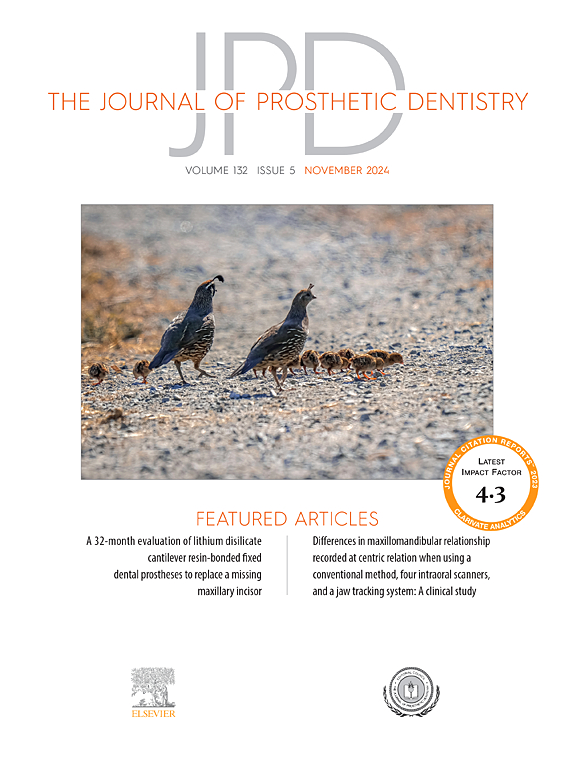Can nonhazardous postprocessing cleaning solutions enable adequate surface properties for printed dental casts in different resins?
IF 4.3
2区 医学
Q1 DENTISTRY, ORAL SURGERY & MEDICINE
引用次数: 0
Abstract
Statement of problem
Printed casts and dental devices and prostheses are increasingly being used, and the ecological impact of additive manufacturing should be considered in addition to the fabrication accuracy and surface properties of the printed object. To overcome the ecological drawbacks of alcohol postprocessing, water-washable, 3-dimensionally (3D) printable cast resins and postprocessing cleaning solutions that do not include alcohol have been introduced. However, whether using only water rather than chemical solvents would enable the surface smoothness and hardness required for accurate diagnostic and prosthetic procedures is unknown.
Purpose
The purpose of this in vitro study was to evaluate the effect of resin type (water-washable or nonwater washable) and postprocessing cleaning solution on the surface roughness and microhardness of 3D printed dental cast resins.
Material and methods
One hundred eight disk-shaped specimens (Ø10×2 mm) were additively manufactured (AM) from 3 dental cast resins: 2 water-washable (Epax (WW1) and Phrozen (WW2)) and 1 nonwater-washable resin (KeyModel Ultra resin-beige (NWW)) with a printer (n=36). Specimens in each resin type were divided into 3 groups for the application of postprocessing cleaning solution (water, 98% isopropyl alcohol [IPA] or methyl ether solvent) and polymerized after cleaning. The surface roughness (Ra, µm) and Vickers microhardness (HV) were measured. Laser microscope images were made of 1 specimen from each group.
Results
NWW-IPA (control group) had a similar Ra to WW2-water (P=.81) and WW2-methyl ether solvent (P=.511). NWW-IPA had lower HV than WW2-water (P<.001) and WW1-methyl ether solvent (P=.001). Solutions had no significant effect on the Ra of WW1 (P≥.554) and WW2 (P≥.805). WW1 had higher surface irregularities with water, whereas no significant difference was visually observed with IPA or methyl ether solvent. Solutions had a similar effect on the surface of WW2 when evaluated visually with the laser microscope.
Conclusions
Resin type and postprocessing cleaning solution affected the surface roughness and microhardness of 3D printed dental cast resins, except for the surface roughness of tested water-washable resins. Water or methyl ether solvent cleaned water-washable resin (WW2) had surface roughness and hardness similar to commonly used nonwater-washable cast resin.
非危险性后处理清洁解决方案能否使不同树脂的印刷牙科铸模具有适当的表面特性?
问题简介:打印铸模和牙科设备及假体的使用越来越多,除了考虑打印物体的制造精度和表面特性外,还应该考虑增材制造对生态环境的影响。为了克服酒精后处理的生态弊端,人们推出了可水洗的三维(3D)可打印铸模树脂和不含酒精的后处理清洁溶液。目的:本体外研究旨在评估树脂类型(可水洗或不可水洗)和后处理清洁溶液对 3D 打印牙科铸模树脂表面粗糙度和微硬度的影响:用打印机对 3 种牙科铸造树脂:2 种可水洗树脂(Epax (WW1) 和 Phrozen (WW2))和 1 种不可水洗树脂(KeyModel Ultra 树脂-米色 (NWW))进行了加成制造(AM),共制作了 18 个圆盘状试样(Ø10×2 毫米)(n=36)。每种树脂的试样分为 3 组,分别使用后处理清洗液(水、98% 异丙醇 [IPA] 或甲醚溶剂),清洗后进行聚合。测量表面粗糙度(Ra,µm)和维氏显微硬度(HV)。对每组中的一个试样进行激光显微镜成像:NWW-IPA(对照组)的 Ra 值与 WW2-水(P=.81)和 WW2-甲醚溶剂(P=.511)相似。NWW-IPA 的 HV 值低于 WW2-水(WW1 的 Pa 值(P≥.554)和 WW2 的 Pa 值(P≥.805))。WW1 在水中的表面不规则度较高,而在 IPA 或甲醚溶剂中则没有明显差异。用激光显微镜目测,溶液对 WW2 表面的影响相似:树脂类型和后处理清洁溶液会影响 3D 打印牙科铸模树脂的表面粗糙度和显微硬度,但测试的水洗树脂的表面粗糙度除外。水或甲醚溶剂清洗过的水洗树脂(WW2)的表面粗糙度和硬度与常用的非水洗铸造树脂相似。
本文章由计算机程序翻译,如有差异,请以英文原文为准。
求助全文
约1分钟内获得全文
求助全文
来源期刊

Journal of Prosthetic Dentistry
医学-牙科与口腔外科
CiteScore
7.00
自引率
13.00%
发文量
599
审稿时长
69 days
期刊介绍:
The Journal of Prosthetic Dentistry is the leading professional journal devoted exclusively to prosthetic and restorative dentistry. The Journal is the official publication for 24 leading U.S. international prosthodontic organizations. The monthly publication features timely, original peer-reviewed articles on the newest techniques, dental materials, and research findings. The Journal serves prosthodontists and dentists in advanced practice, and features color photos that illustrate many step-by-step procedures. The Journal of Prosthetic Dentistry is included in Index Medicus and CINAHL.
 求助内容:
求助内容: 应助结果提醒方式:
应助结果提醒方式:


